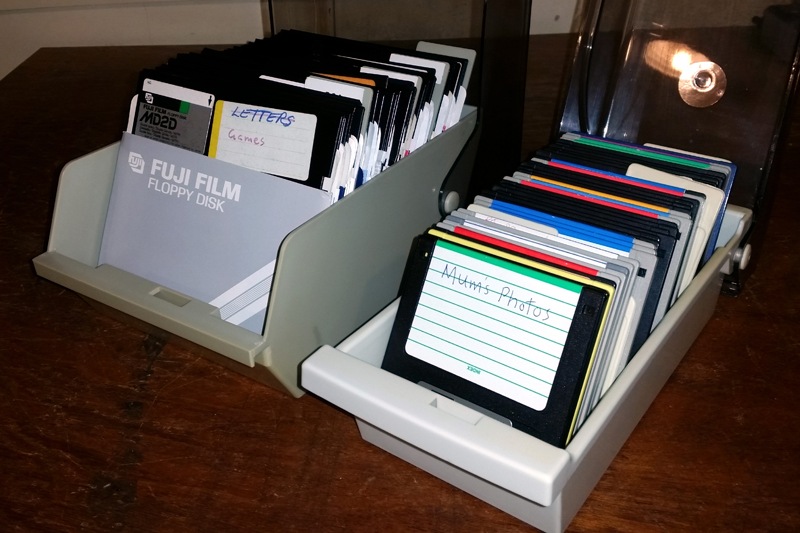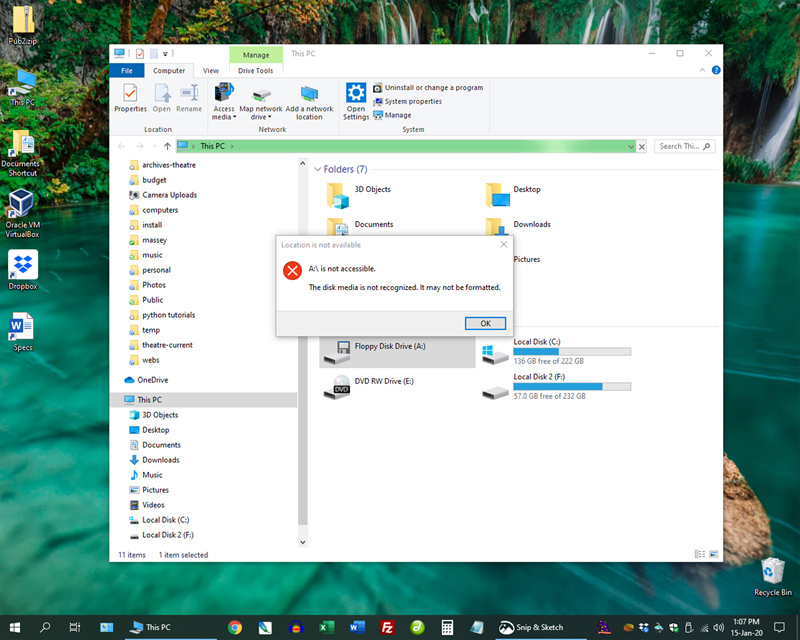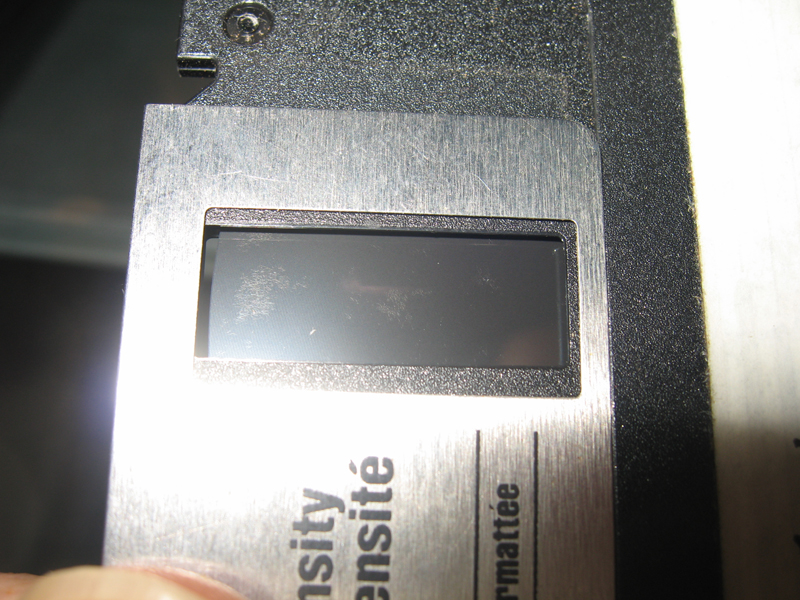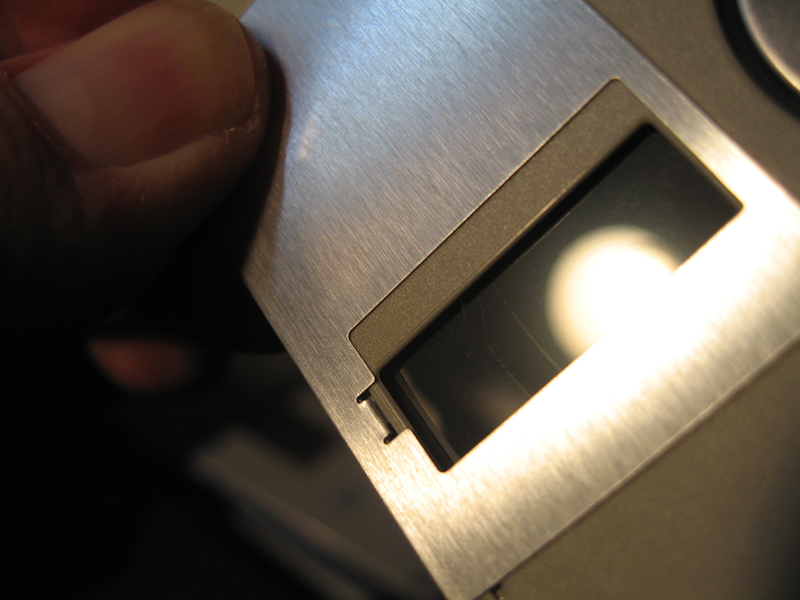| Tweet |
Why can’t my computer read my floppy disks? One possibility: disk degradation and/or damage.
Introduction
Note: This article is a quick guide focusing on common floppy disk problems that prevent files being recovered. The target reader is the casual user wanting to check out old disks which have surfaced. If you are a vintage computer hobbyist or enthusiast wanting to take a deep dive into the topic, best check out Herb Johnson’s page.

Figure 1. Forgotten disks from way back. What's on them?
So, you’ve bought one of those cheap USB floppy disk drives to archive those old PC disks which you’ve found at the bottom of the closet. However, things are not going as well as you’d hoped.

Figure 2 - Floppy disk read fail!
You struggle to get even a directory and many times the computer does not recognize the disk is formatted at all. What could be wrong?
Disk, drive or computer?
It’s possible there could be a hardware or driver issue. However, before you start searching the web for hardware solutions and fiddling around with drive alignment etc. consider the MOST likely problem: the media itself. This article discusses disk media and give tips on how to visually assess the health of floppy disks.
What can go wrong with floppy disks
Floppy disks are covered with magnetic storage media. As the years go by this can degrade, lose its magnetic orientation and/or become loose on the mylar surface. Humid conditions can cause fungi to grow on the media. Furthermore, with 3.5 inch floppy disks, the glue sticking the metal hub (at the centre) to the mylar can become unstuck. How quickly all or any of these things happen depends on how well the disks were manufactured in the first place, and how well they have been stored.
So, what are the signs that disk media has a problem? Loose, degraded or damaged media is not always obvious but many times it is! In my experience there are three common visual clues that suggest your disks are not be as good as they once were. These cases are listed below...
1. Fungi
Pull back the disk cover (if it has one) so you can see the surface of the disk and rotate it manually. If you see white specs or spots then you have fungi growing on the disk (Figure 3).

Figure 3. Specks of fungi on a 3.5 inch floppy disk
It’s best never to try to read disks that look like this without removing the fungi. This loose material will aggregate on disk drive read/write heads leading to errors. Residue can build up very quickly on the heads, which can then lead to the second problem….
2. Destroyed media (often, but not exclusively, due to problem 1)
Drive heads are only floating a few microns from the disk surface when reading disk contents. Fungi or loose media can build up as a residue on the heads and reduce that gap to zero. Once this occurs the heads make physical contact with the disk! The heads then carve out grooves in the disk, obliterating any magnetic media and with it any data. This damage is often visible on the disk surface as a groove or grooves.

Figure 3a. Grooves carved into a 3.5 inch floppy disk from dirty read/write heads

Figure 3b. Grooves carved into a 5.25 inch floppy disk from dirty drive read/write heads
Often it’s a single groove where the directory track would be. This track is often destroyed first, as a drive with dirty heads will access the same track time and time again looking for directory data. Once the directory is destroyed, files are difficult to reconstruct. Furthermore, a disk drive with dirty read/write heads can become a “destroyer drive” wrecking every subsequent disk which is inserted, even good ones! The heads must be cleaned. If your disks seem free of fungi but suddenly have grooves cut into them after an unsuccessful read, consider that disk drive you bought off e-bay, found in the garage, borrowed from someone or pulled from some ‘90s e-waste might have dirty heads. It just takes one “dirty disk” to turn a drive into a disk destroyer.
3. The hub has come unglued from the mylar disk
This can be a problem with 3.5 disks. Over time the glue used to bind the metal hub in the centre of the disk to the mylar platter can weaken. Eventually, it can become unglued. The hub will spin but the disk won’t.

Figure 4. Detached hub from a 3.5 inch floppy disk
To check, turn the hub manually and check that the disk is moving within its jacket in conjunction with it. Eight and 5.25 inch disks don’t have a metal hub so it’s not an issue with these.
Ok, I have one of these problems. Are the disks a lost cause?
Not necessarily depending on the problem. Fungi can be washed from the surface quite safely using various techniques. Often 100% of the data can be recovered. Destroyed media from a dirty drive head can’t be recovered BUT some files (like text files) can be rebuilt or recovered even if data is missing. I provide a floppy disk file recovery service where I can both remove fungi from disks and/or attempt to recover data from damaged disks. If interested, check it out.
If the hub has come unglued it is virtually impossible to retrieve anything. The hub can be reglued but tolerances are so fine, it’s never in EXACTLY the same place so data is very hard to retrieve. People have done it, but it needs special hardware and software.
Final thoughts
As mentioned above, its not always the media that’s at fault and even if it is, there are not always visible signs. However, if the disk media shows the signs described above, then it’s strong evidence the disks rather than the hardware are at fault.
Terry Stewart
14th January, 2020
| Tweet |